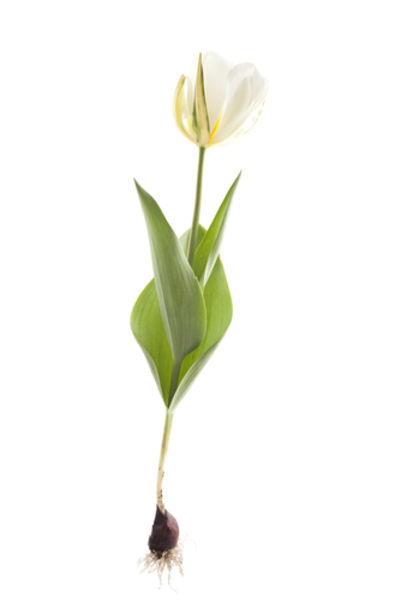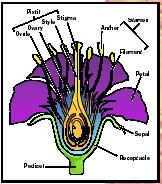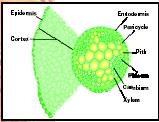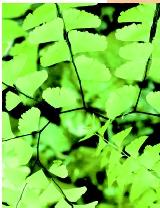Anatomy of Plants

Plants are the primary producers in Earth's ecosystem . Plants are autotrophic, meaning that they produce their own food (via photosynthesis), and as a result ultimately produce food for the ecosystem's consumers (such as humans). Understanding plant function is the key to enhancing crop production, preserving plant biodiversity, producing medicines, and much more. However, in order to understand plant function, one must understand plant form.
General Anatomical Organization of Plants
Like animals, plant bodies are made up of a variety of cell types that are organized into tissues. Tissues are organized into organs, and organs function together within systems. Within this hierarchy of structure, emergent properties arise at each level. An emergent property is a characteristic or function that can be found at one level that is not present at lower levels. For example, an individual cell of a leaf cannot perform all of the functions of the leaf, but the cells of the leaf collectively perform the function of a leaf. Therefore, the function of each lower level is best understood in the context of the system in which it exists. For this reason, this article begins by exploring the gross anatomical features of a plant and proceeds to examine the anatomy in progressive detail.

Plants are made up of two organ systems: the shoot system and the root system. For terrestrial plants the shoot system is above ground and consists of a number of organs. These include stems, leaves, and flowers. On the other hand, the root system is most often underground and consists of organs such as roots, underground stems (tubers), and rhizomes.
Each of these organs performs a different function. Stems are support structures and mediate the growth of the plant. Shoot tips contain actively dividing regions called meristems, which produce auxin, a hormone that regulates the growth and shape of the plant. Leaves are the primary sites of photosynthesis, so they are the food production centers of the plant. Flowers are reproductive structures, where eggs and sperm (pollen) are produced and where pollination and fertilization occur. Roots, tubers, and rhizomes are the main system for nutrient and water acquisition and storage. All of these organs are made up of cells that can be categorized into three major tissue types: dermal, ground, and vascular tissue.
Dermal Tissue
Dermal tissue makes up the outer layers of the plant and contains epidermal cells that secrete and are coated with a waxy layer. This waxy coating, the cuticle, prevents excessive water loss from the plant. While the dermal tissue primarily serves a protective role, it also has a variety of other specialized functions depending on the particular organ where it is located.
In leaves, dermal tissue contains specialized cells called guard cells that make up structures called stomata . Stomata facilitate the exchange of gases in the leaf. Carbon dioxide (CO 2 ) diffuses into the leaf through the stomata for use in photosynthesis, and oxygen (O 2 ), the waste product of photosynthesis, diffuses out of the leaf through stomata. Stomata are also crucial for water transport through the xylem . Stomatal opening results in the evaporation of water from the air spaces of the leaf. This creates negative water pressure that pulls on the column of water in the xylem. The evaporation of water from the stomata is the main driving force for water transport through the water. In roots, epidermal cells have a specialized structure that facilitates water and nutrient absorption, the main function of the root. Some of the root epidermal cells have long membranous extensions called root hairs that increase the absorptive surface area of the root. Root epidermis also interacts with symbiotic fungi that form mycorrhizae , which increase nutrient absorption.
Ground Tissue
Many different functions are performed by ground tissue including photosynthesis, storage, and support. Ground tissue makes up the majority of the plant structure and is composed of three cell types: parenchyma, collenchyma, and sclerenchyma cells.
Parenchyma cells are the least specialized cells in a plant. These cells are responsible for the production and storage of nutrients. Photosynthesis occurs in the chloroplasts of parenchyma cells in leaves. Parenchyma cells in stems, roots, and fruits have structures that store starch. Most developing plant cells are structurally similar to parenchyma cells. During their differentiation, they become specialized in form and function and lose the potential to divide. Mature parenchyma cells do not usually divide, but they retain the ability to divide and differentiate into different cell and tissue types in the event of an injury to the plant.

Collenchyma and sclerenchyma cells provide structural support for the plant. Collenchyma cells have thick, yet pliable, cell walls. These cells give structural support to newly formed portions of a plant without restricting growth. Collenchyma cells are stacked end on end and are oriented in strands just beneath the epidermis of the young structure. The relatively soft cell wall allows the collenchyma cells to elongate as the structure grows.
On the other hand, sclerenchyma cells provide support to mature plant structures. Like collenchyma cells, they have very thick cell walls. However, the cell walls of sclerenchyma cells contain lignin , a molecule that makes the cell wall hard. This provides strength to the cell wall, but restricts the ability of the cells to elongate and grow. Since a sclerenchyma cell functions solely to provide structural support, many sclerenchyma cells are actually dead at functional maturity. The cell membrane, protoplasm (cytoplasm) and organelles are gone, leaving only the rigid cell wall that serves as a scaffolding system for that structure.
Vascular Tissue
Vascular tissues make up the organs that transport water, minerals , and food throughout the plant. Vascular tissue can be divided into two functional units. Xylem transports water and minerals from root to shoot. phloem transports nutrients (such as sugar and amino acids ) from leaves and other production sites to roots, flowers, stems, and other tissues that need them. The cells that make up vascular tissue are unique in their structure. Their specialized characteristics allow them to transport material through the plant efficiently while providing structural support to the plant.
Xylem tissue contains two types of cells: tracheids and vessel elements. Like sclerenchyma, both of these cell types are dead at functional maturity and therefore lack protoplasm. Tracheids are long, thin cells that have tapered ends. They overlap on another, and water passes from tracheid to tracheid via small pores. Vessel elements are shorter and are stacked end to end, forming more of a tube structure. Water flows in the tube by passing through perforated end walls between cells.

Phloem tissue is made up of two different types of cells: sieve tube members and companion cells. Sieve tube members are the main conducting cells, and are named for the sievelike areas along their cell walls through which the phloem sap moves from cell to cell. Unlike cells of the xylem, sieve tube members are alive at functional maturity, but do not have nuclei. For this reason, companion cells are closely associated with sieve tube members. These cells do have nuclei and serve to support the sieve tube members. The cytoplasm of sieve tube members and companion cells is connected through numerous pores called plasmodesmata. These pores allow the companion cells to regulate the content and activity of the sieve tube member's cytoplasm. Moreover, the companion cells help to load the sieve tube members with sugar and the other metabolic products that they transport throughout the plant.
SEE ALSO Algae ; Angiosperms ; Bryophytes ; Cell Wall ; Conifers ; Fruits ; Gymnosperms ; Leaves ; Meristems ; Mycorrhizae ; Pteridophytes ; Roots ; Shoots ; Translocation ; Water Movement in Plants
Susan T. Rouse
Bibliography
Atlas of Plant Anatomy. <http://atlasveg.ib.usp.br/English/> .
Moore, Randy, et al. Botany, 2nd ed. New York: McGraw-Hill, 1999.
}Plant Anatomy Images. University of Rhode Island. <http://www.uri.edu/artsci/bio/plant_anatomy/images.html> .
Comment about this article, ask questions, or add new information about this topic: